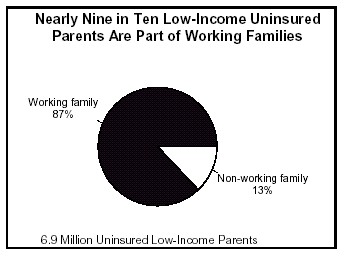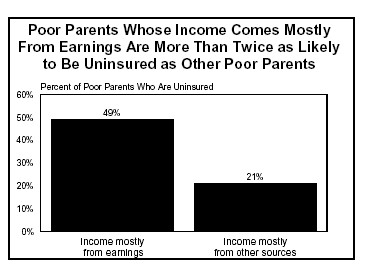THE VAST MAJORITY OF LOW-INCOME
UNINSURED PARENTS ARE PART OF WORKING FAMILIES:
A FACT SHEET
Although it is commonly thought that low-income parents who are uninsured lack coverage because they have little or no connection to the workforce, the reality is that the vast majority of low-income uninsured parents are part of working families. In fact, as explained in more detail in this fact sheet, low-income parents are far more likely to be uninsured if they are working than if they are not. (For purposes of this fact sheet, low-income is defined at those with family income below 200 percent of the poverty line, $29,260 a year for a family of three.)
Most Low-Income Uninsured Parents Are in Working Families
 n 1999, the latest year for which these data are available, 6.9 million
low-income parents caring for children age 18 or younger one of every three in the
country were uninsured. Nearly nine of every ten low-income uninsured parents
87 percent of them are members of working families.(1)
n 1999, the latest year for which these data are available, 6.9 million
low-income parents caring for children age 18 or younger one of every three in the
country were uninsured. Nearly nine of every ten low-income uninsured parents
87 percent of them are members of working families.(1)
Low-income parents are at high risk of being uninsured even though they are working, in large part because they often do not have access to affordable employer-based coverage through their own or a spouse's job. For example, among workers who earn less than $20,000 a year, almost half are not offered health insurance by their employers, and many who are offered insurance at work decline it because they cannot afford the insurance premiums.(2)
It can be particularly difficult for low-income parents who work in certain types of jobs to secure coverage. People who work in fields like agriculture, forestry, fishing, mining or construction are about twice as likely to be uninsured as others and those in retail and service sector jobs also are more likely to lack coverage. Employers in these sectors are less likely to offer health insurance to their workers. Parents who work in small businesses also are much less likely to be offered employer-based insurance. In addition, some parents work for employers that offer coverage, but the parents are not eligible to participate because they have only recently started their jobs or work part-time. Finally, in most companies, the share of the insurance premium that an employee must pay is the same no matter how much a worker earns, so low-income workers can have a harder time affording insurance when it is offered.(3) The bottom line is that millions of parents work hard but are unable to obtain affordable health insurance through their employers.
Parents' Eligibility Levels Are Often Set Far Below the Poverty Line
 At the same time, low-income working parents are largely ineligible
for publicly-subsidized coverage. The majority of states provide coverage to parents
only if the parents are poor enough to qualify for welfare. Half of all states provide
coverage to a working parent with two children only if the parent's earnings fall below
roughly $10,000 a year, an amount that leaves the family nearly $5,000 below the poverty
line. In the typical (or median) state, a working parent with two children becomes
ineligible for coverage when her earnings reach 69 percent of the poverty line. In some
states, the eligibility cutoff for parents is even lower. In Alabama, a parent with two
children is ineligible for Medicaid if the parent's earnings exceed $3,048 a year, an
amount that leaves the family more than $11,500 below the poverty line.
At the same time, low-income working parents are largely ineligible
for publicly-subsidized coverage. The majority of states provide coverage to parents
only if the parents are poor enough to qualify for welfare. Half of all states provide
coverage to a working parent with two children only if the parent's earnings fall below
roughly $10,000 a year, an amount that leaves the family nearly $5,000 below the poverty
line. In the typical (or median) state, a working parent with two children becomes
ineligible for coverage when her earnings reach 69 percent of the poverty line. In some
states, the eligibility cutoff for parents is even lower. In Alabama, a parent with two
children is ineligible for Medicaid if the parent's earnings exceed $3,048 a year, an
amount that leaves the family more than $11,500 below the poverty line.
In most states, low-income parents thus face the prospect that if they or other family members earn enough to stay off welfare, they must forego health insurance coverage. (For additional information on state-specific eligibility thresholds for working parents, see Jocelyn Guyer, Congress Has a $28 Billion Opportunity to Expand Coverage for Families with Children, Center on Budget and Policy Priorities, July 2001 at www.cbpp.org).
Low-Income Working Parents Are More Likely to Be Uninsured
As a result of the low income eligibility limits for publicly-subsidized coverage that apply to parents in many states and the limited availability of employer-based coverage at low-wage jobs, low-income working parents are more likely to be uninsured than their unemployed counterparts. In 1999, for example, 36 percent of low-income parents who secured a majority of their income from earnings were uninsured. In comparison, a little more than one in five low-income parents (22 percent) who derived a majority of their income from sources other than earnings were uninsured.
The uninsured rate of those parents in poor families whose primary source of income is earnings is particularly high close to half (49 percent) of these parents are uninsured. In comparison, a little more than one in five poor parents (22 percent) who derived a majority of their income from sources other than earnings were uninsured.
References
1. The data on the number and characteristics of uninsured parents in this fact sheet are based on CBPP's tabulations of the March 2000 Current Population Survey which provides information on the health insurance status and income of individuals in 1999. CBPP defined "parents" to include household heads and their spouses between the ages of 18 and 65 living with children.
2. Lisa Duchon, Cathy Schoen, Elisabeth Simantov, Karen Davis, and Christina An, "Listening to Workers: Challenges for Employer-Sponsored Coverage in the 21st Century," Commonwealth Fund, January 2000.
3. See, for example, Paul Fronstin, "Sources of Health Insurance and Characteristics of the Uninsured: Analysis of the March 2000 Current Population Survey," Employee Benefits Research Institute Issue Brief, Dec. 2000 or, Jon Gabel, et al. "Embraceable You: How Employers Influence Health Plan Enrollment," Health Affairs, 20(4):196-208, Jul./Aug. 2001.